Zijun Chen
ProtoReasoning: Prototypes as the Foundation for Generalizable Reasoning in LLMs
Jun 18, 2025Abstract:Recent advances in Large Reasoning Models (LRMs) trained with Long Chain-of-Thought (Long CoT) reasoning have demonstrated remarkable cross-domain generalization capabilities. However, the underlying mechanisms supporting such transfer remain poorly understood. We hypothesize that cross-domain generalization arises from shared abstract reasoning prototypes -- fundamental reasoning patterns that capture the essence of problems across domains. These prototypes minimize the nuances of the representation, revealing that seemingly diverse tasks are grounded in shared reasoning structures.Based on this hypothesis, we propose ProtoReasoning, a framework that enhances the reasoning ability of LLMs by leveraging scalable and verifiable prototypical representations (Prolog for logical reasoning, PDDL for planning).ProtoReasoning features: (1) an automated prototype construction pipeline that transforms problems into corresponding prototype representations; (2) a comprehensive verification system providing reliable feedback through Prolog/PDDL interpreters; (3) the scalability to synthesize problems arbitrarily within prototype space while ensuring correctness. Extensive experiments show that ProtoReasoning achieves 4.7% improvement over baseline models on logical reasoning (Enigmata-Eval), 6.3% improvement on planning tasks, 4.0% improvement on general reasoning (MMLU) and 1.0% on mathematics (AIME24). Significantly, our ablation studies confirm that learning in prototype space also demonstrates enhanced generalization to structurally similar problems compared to training solely on natural language representations, validating our hypothesis that reasoning prototypes serve as the foundation for generalizable reasoning in large language models.
Understanding and Benchmarking the Trustworthiness in Multimodal LLMs for Video Understanding
Jun 14, 2025Abstract:Recent advancements in multimodal large language models for video understanding (videoLLMs) have improved their ability to process dynamic multimodal data. However, trustworthiness challenges factual inaccuracies, harmful content, biases, hallucinations, and privacy risks, undermine reliability due to video data's spatiotemporal complexities. This study introduces Trust-videoLLMs, a comprehensive benchmark evaluating videoLLMs across five dimensions: truthfulness, safety, robustness, fairness, and privacy. Comprising 30 tasks with adapted, synthetic, and annotated videos, the framework assesses dynamic visual scenarios, cross-modal interactions, and real-world safety concerns. Our evaluation of 23 state-of-the-art videoLLMs (5 commercial,18 open-source) reveals significant limitations in dynamic visual scene understanding and cross-modal perturbation resilience. Open-source videoLLMs show occasional truthfulness advantages but inferior overall credibility compared to commercial models, with data diversity outperforming scale effects. These findings highlight the need for advanced safety alignment to enhance capabilities. Trust-videoLLMs provides a publicly available, extensible toolbox for standardized trustworthiness assessments, bridging the gap between accuracy-focused benchmarks and critical demands for robustness, safety, fairness, and privacy.
Sample Complexity of Distributionally Robust Average-Reward Reinforcement Learning
May 15, 2025Abstract:Motivated by practical applications where stable long-term performance is critical-such as robotics, operations research, and healthcare-we study the problem of distributionally robust (DR) average-reward reinforcement learning. We propose two algorithms that achieve near-optimal sample complexity. The first reduces the problem to a DR discounted Markov decision process (MDP), while the second, Anchored DR Average-Reward MDP, introduces an anchoring state to stabilize the controlled transition kernels within the uncertainty set. Assuming the nominal MDP is uniformly ergodic, we prove that both algorithms attain a sample complexity of $\widetilde{O}\left(|\mathbf{S}||\mathbf{A}| t_{\mathrm{mix}}^2\varepsilon^{-2}\right)$ for estimating the optimal policy as well as the robust average reward under KL and $f_k$-divergence-based uncertainty sets, provided the uncertainty radius is sufficiently small. Here, $\varepsilon$ is the target accuracy, $|\mathbf{S}|$ and $|\mathbf{A}|$ denote the sizes of the state and action spaces, and $t_{\mathrm{mix}}$ is the mixing time of the nominal MDP. This represents the first finite-sample convergence guarantee for DR average-reward reinforcement learning. We further validate the convergence rates of our algorithms through numerical experiments.
TrustGeoGen: Scalable and Formal-Verified Data Engine for Trustworthy Multi-modal Geometric Problem Solving
Apr 22, 2025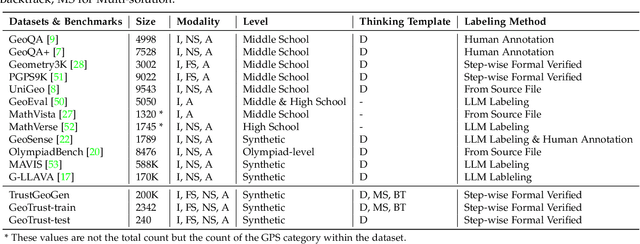
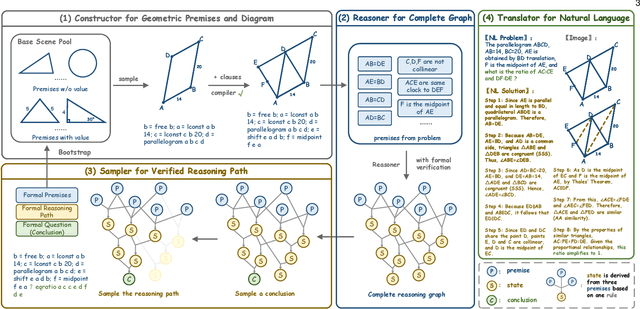
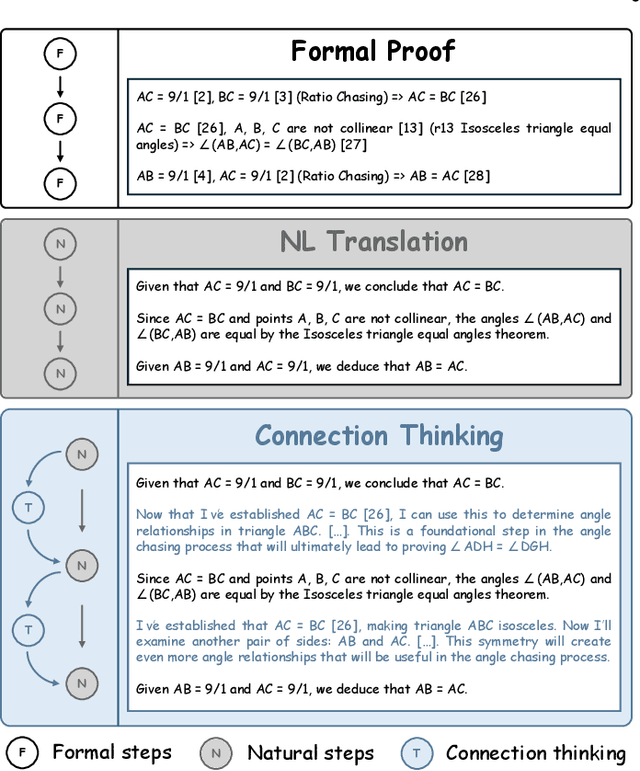

Abstract:Mathematical geometric problem solving (GPS) often requires effective integration of multimodal information and verifiable logical coherence. Despite the fast development of large language models in general problem solving, it remains unresolved regarding with both methodology and benchmarks, especially given the fact that exiting synthetic GPS benchmarks are often not self-verified and contain noise and self-contradicted information due to the illusion of LLMs. In this paper, we propose a scalable data engine called TrustGeoGen for problem generation, with formal verification to provide a principled benchmark, which we believe lays the foundation for the further development of methods for GPS. The engine synthesizes geometric data through four key innovations: 1) multimodal-aligned generation of diagrams, textual descriptions, and stepwise solutions; 2) formal verification ensuring rule-compliant reasoning paths; 3) a bootstrapping mechanism enabling complexity escalation via recursive state generation and 4) our devised GeoExplore series algorithms simultaneously produce multi-solution variants and self-reflective backtracking traces. By formal logical verification, TrustGeoGen produces GeoTrust-200K dataset with guaranteed modality integrity, along with GeoTrust-test testset. Experiments reveal the state-of-the-art models achieve only 49.17\% accuracy on GeoTrust-test, demonstrating its evaluation stringency. Crucially, models trained on GeoTrust achieve OOD generalization on GeoQA, significantly reducing logical inconsistencies relative to pseudo-label annotated by OpenAI-o1. Our code is available at https://github.com/Alpha-Innovator/TrustGeoGen
Unveiling Uncertainty: A Deep Dive into Calibration and Performance of Multimodal Large Language Models
Dec 19, 2024



Abstract:Multimodal large language models (MLLMs) combine visual and textual data for tasks such as image captioning and visual question answering. Proper uncertainty calibration is crucial, yet challenging, for reliable use in areas like healthcare and autonomous driving. This paper investigates representative MLLMs, focusing on their calibration across various scenarios, including before and after visual fine-tuning, as well as before and after multimodal training of the base LLMs. We observed miscalibration in their performance, and at the same time, no significant differences in calibration across these scenarios. We also highlight how uncertainty differs between text and images and how their integration affects overall uncertainty. To better understand MLLMs' miscalibration and their ability to self-assess uncertainty, we construct the IDK (I don't know) dataset, which is key to evaluating how they handle unknowns. Our findings reveal that MLLMs tend to give answers rather than admit uncertainty, but this self-assessment improves with proper prompt adjustments. Finally, to calibrate MLLMs and enhance model reliability, we propose techniques such as temperature scaling and iterative prompt optimization. Our results provide insights into improving MLLMs for effective and responsible deployment in multimodal applications. Code and IDK dataset: \href{https://github.com/hfutml/Calibration-MLLM}{https://github.com/hfutml/Calibration-MLLM}.
Dual-Phase Accelerated Prompt Optimization
Jun 19, 2024



Abstract:Gradient-free prompt optimization methods have made significant strides in enhancing the performance of closed-source Large Language Models (LLMs) across a wide range of tasks. However, existing approaches make light of the importance of high-quality prompt initialization and the identification of effective optimization directions, thus resulting in substantial optimization steps to obtain satisfactory performance. In this light, we aim to accelerate prompt optimization process to tackle the challenge of low convergence rate. We propose a dual-phase approach which starts with generating high-quality initial prompts by adopting a well-designed meta-instruction to delve into task-specific information, and iteratively optimize the prompts at the sentence level, leveraging previous tuning experience to expand prompt candidates and accept effective ones. Extensive experiments on eight datasets demonstrate the effectiveness of our proposed method, achieving a consistent accuracy gain over baselines with less than five optimization steps.
AMP: Autoregressive Motion Prediction Revisited with Next Token Prediction for Autonomous Driving
Mar 21, 2024



Abstract:As an essential task in autonomous driving (AD), motion prediction aims to predict the future states of surround objects for navigation. One natural solution is to estimate the position of other agents in a step-by-step manner where each predicted time-step is conditioned on both observed time-steps and previously predicted time-steps, i.e., autoregressive prediction. Pioneering works like SocialLSTM and MFP design their decoders based on this intuition. However, almost all state-of-the-art works assume that all predicted time-steps are independent conditioned on observed time-steps, where they use a single linear layer to generate positions of all time-steps simultaneously. They dominate most motion prediction leaderboards due to the simplicity of training MLPs compared to autoregressive networks. In this paper, we introduce the GPT style next token prediction into motion forecasting. In this way, the input and output could be represented in a unified space and thus the autoregressive prediction becomes more feasible. However, different from language data which is composed of homogeneous units -words, the elements in the driving scene could have complex spatial-temporal and semantic relations. To this end, we propose to adopt three factorized attention modules with different neighbors for information aggregation and different position encoding styles to capture their relations, e.g., encoding the transformation between coordinate systems for spatial relativity while adopting RoPE for temporal relativity. Empirically, by equipping with the aforementioned tailored designs, the proposed method achieves state-of-the-art performance in the Waymo Open Motion and Waymo Interaction datasets. Notably, AMP outperforms other recent autoregressive motion prediction methods: MotionLM and StateTransformer, which demonstrates the effectiveness of the proposed designs.
ChartX & ChartVLM: A Versatile Benchmark and Foundation Model for Complicated Chart Reasoning
Feb 19, 2024Abstract:Recently, many versatile Multi-modal Large Language Models (MLLMs) have emerged continuously. However, their capacity to query information depicted in visual charts and engage in reasoning based on the queried contents remains under-explored. In this paper, to comprehensively and rigorously benchmark the ability of the off-the-shelf MLLMs in the chart domain, we construct ChartX, a multi-modal evaluation set covering 18 chart types, 7 chart tasks, 22 disciplinary topics, and high-quality chart data. Besides, we develop ChartVLM to offer a new perspective on handling multi-modal tasks that strongly depend on interpretable patterns, such as reasoning tasks in the field of charts or geometric images. We evaluate the chart-related ability of mainstream MLLMs and our ChartVLM on the proposed ChartX evaluation set. Extensive experiments demonstrate that ChartVLM surpasses both versatile and chart-related large models, achieving results comparable to GPT-4V. We believe that our study can pave the way for further exploration in creating a more comprehensive chart evaluation set and developing more interpretable multi-modal models. Both ChartX and ChartVLM are available at: https://github.com/UniModal4Reasoning/ChartVLM
Cross-Task Linearity Emerges in the Pretraining-Finetuning Paradigm
Feb 06, 2024



Abstract:The pretraining-finetuning paradigm has become the prevailing trend in modern deep learning. In this work, we discover an intriguing linear phenomenon in models that are initialized from a common pretrained checkpoint and finetuned on different tasks, termed as Cross-Task Linearity (CTL). Specifically, if we linearly interpolate the weights of two finetuned models, the features in the weight-interpolated model are approximately equal to the linear interpolation of features in two finetuned models at each layer. Such cross-task linearity has not been noted in peer literature. We provide comprehensive empirical evidence supporting that CTL consistently occurs for finetuned models that start from the same pretrained checkpoint. We conjecture that in the pretraining-finetuning paradigm, neural networks essentially function as linear maps, mapping from the parameter space to the feature space. Based on this viewpoint, our study unveils novel insights into explaining model merging/editing, particularly by translating operations from the parameter space to the feature space. Furthermore, we delve deeper into the underlying factors for the emergence of CTL, emphasizing the impact of pretraining.
Learning Non-Markovian Quantum Noise from Moiré-Enhanced Swap Spectroscopy with Deep Evolutionary Algorithm
Dec 09, 2019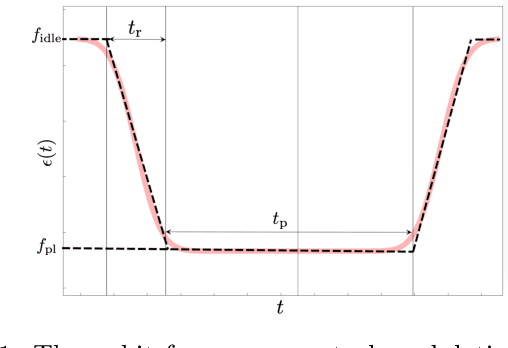
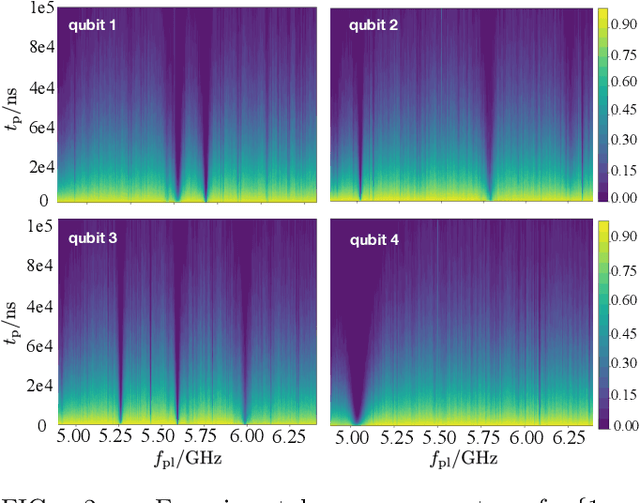
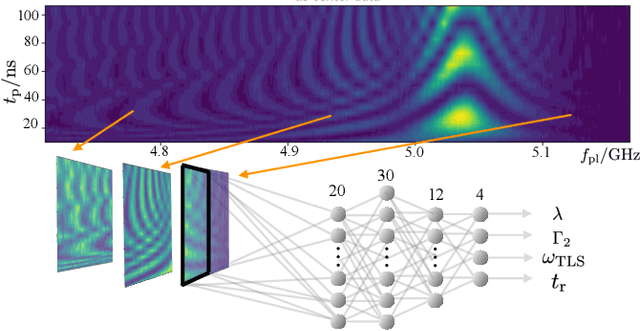
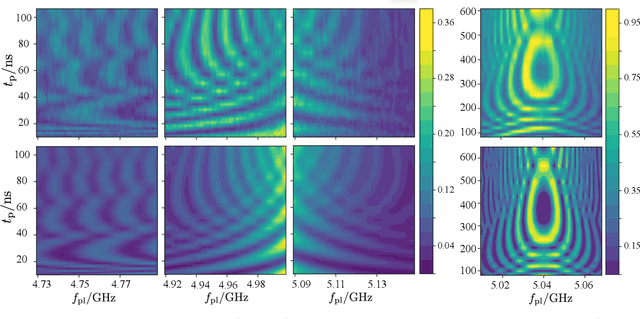
Abstract:Two-level-system (TLS) defects in amorphous dielectrics are a major source of noise and decoherence in solid-state qubits. Gate-dependent non-Markovian errors caused by TLS-qubit coupling are detrimental to fault-tolerant quantum computation and have not been rigorously treated in the existing literature. In this work, we derive the non-Markovian dynamics between TLS and qubits during a SWAP-like two-qubit gate and the associated average gate fidelity for frequency-tunable Transmon qubits. This gate dependent error model facilitates using qubits as sensors to simultaneously learn practical imperfections in both the qubit's environment and control waveforms. We combine the-state-of-art machine learning algorithm with Moir\'{e}-enhanced swap spectroscopy to achieve robust learning using noisy experimental data. Deep neural networks are used to represent the functional map from experimental data to TLS parameters and are trained through an evolutionary algorithm. Our method achieves the highest learning efficiency and robustness against experimental imperfections to-date, representing an important step towards in-situ quantum control optimization over environmental and control defects.
 Add to Chrome
Add to Chrome Add to Firefox
Add to Firefox Add to Edge
Add to Edge